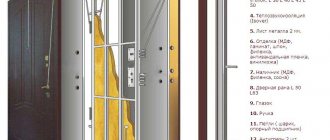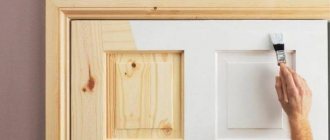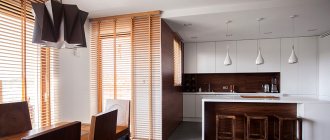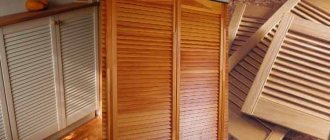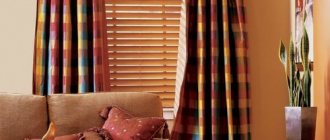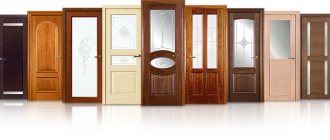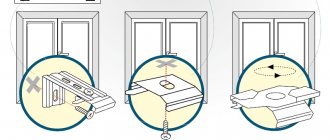Wooden shutter doors look great as the front of wall cabinets, kitchen furniture and as interior furniture. It is possible to make shutter doors with your own hands, but you need to know the technology.
Louver doors are gaining popularity in modern design. They are used in furniture production and installed as interior doors. The cost of such doors is quite high, so many people wonder whether it is possible to make such a door themselves. Let's try to figure out how a shutter door works, what advantages and disadvantages it has, and how to make such a design with your own hands.
Features, advantages and disadvantages
The properties of louvered doors are determined by their design - the presence of transverse slats. They have the following advantages:
- Good ventilation. Louvre doors offer little obstruction to air movement, so there are no problems with high humidity or stale air. Even in closed, rarely used rooms.
- Better heat distribution. It is difficult to ensure normal air conditions in unheated rooms with ordinary doors. The presence of blinds solves this problem. In storage rooms and technical rooms separated by louvered doors, the temperature is automatically equalized.
Louvered doors create almost no barriers to air movement - Visually “lighter” doors with blinds look interesting and put less strain on the interior.
- Interesting appearance. This design, of course, is not for everyone, but in some styles it looks very good.
Doors with a large number of slats and gaps between them are more technologically complex. Their production requires attention, precision, and accuracy. Only under such conditions will the result be good - it will be pleasant to use and look at. This is why louvered doors are much more expensive than regular doors. And this despite the fact that only the frame is made from solid wood. Partitions-lamellas are made of laminated wood. This is due to the fact that thin wooden planks will “twist” when humidity changes. The presence of several layers with multidirectional fibers interspersed with layers of glue allows us to solve the problem.
Other disadvantages:
- Lack of sound insulation. The presence of a large number of gaps between the slats negates all soundproofing characteristics. In this regard, it doesn’t matter whether these doors exist or not.
- Free movement of dust. One area where roller doors can be used is in wardrobes. But the clothes placed in them are in no way protected from dust, which is more than enough in our homes.
When using blinds on cabinet doors, dust easily penetrates inside
The disadvantages of louvered doors are quite serious. Before installation, you should think seriously and decide what is more important to you: their advantages or disadvantages.
DIY shutter doors. Step-by-step instruction
The procedure for making a door with louvered slats is as follows:
- First, the bars from which the frame will be made are cut according to previously determined dimensions.
- The lamellas are made using a thickness planer, and the corners are removed using a router.
- Using a router, fastening grooves for the lamellas are cut out in the side bars. This is a very important operation, on which the quality of the door as a whole depends. The size of each cut and the angle of inclination must be measured as carefully as possible so that there are no problems during assembly.
- All parts must be carefully sanded. First, take medium-grain paper, and then fine-grain paper. After which all elements are painted over.
- In one of the vertical racks, grooves are selected and dowels are placed in each groove.
- The slats are placed in the inclined grooves. When everything is ready, the horizontal crossbars are fixed to dowels. The last element is the second vertical stand.
The assembly procedure is shown in the figure. To make the structure stronger, the dowels are lubricated with PVA glue.
How to paint a louvered door
It is better to paint the door with a spray gun. However, if it is not there, you can take a brush. Ideal quality is obtained if all elements are painted separately. But if the entire door is being painted, you need to carefully work through all the joints with a thin brush.
Application area
The scope of use of louvered doors is determined by their properties. They are indispensable in rooms that require constant ventilation. At the same time, the degree of sound insulation should not be important for these rooms. There are several such rooms in our houses and apartments:
- Technical rooms - storage rooms, laundries, wardrobes. In the case of dressing rooms, it is worth thinking about the feasibility of this option. After all, it is advisable to protect clothes from dust. A compromise is possible: make a louvered grille in the upper part, where there is less dust and the warmest air accumulates.
- Bathroom. In the bathroom, it is desirable to quickly remove excess moisture and louvered doors will help with this. But this option is only good if the bathroom is separate, since a combined bathroom will become a source of not very pleasant sounds and smells.
Louvered doors to technical rooms are an excellent option to achieve ventilation without organizing a special air duct - Boiler rooms facing the street. The street door for such a room may have a louvered grille. Only it should be adjustable so as not to make the room too cold in winter. One thing: before installing such doors, check with your local fire department. Just in case.
In addition to serving as doors between rooms, louvered structures can be used in furniture. They are good:
- In kitchen cabinets, both floor and wall mounted. In the dryer and the cupboard with cereals they provide quick ventilation, in the rest - more like decorative ones.
- In cabinets that cover the pipes in the toilet as an enclosing structure. You can hang them on hinges, or you can put them on magnets.
In bathrooms, toilets, kitchen cabinets can be used as cabinet doors - As blinds on windows. The problem of light scattering is solved very well. It does not cut off completely, creating twilight lighting.
- For wardrobes, chests of drawers and other furniture located in living rooms. The advantages in this case outweigh the disadvantages, and the appearance is interesting.
Another area of application is as shading structures with a large glazing area. On terraces, winter gardens, large balconies and loggias with continuous glazing. Why are louvered doors better than regular blinds? The fact that “fixed doors can be opened while leaving shutter doors closed. There will be free air access and there will be no too bright light.
Louvre doors can be used as shading
As a partition that delimits a room. For example, fencing off the sleeping area in a studio apartment. This option is ideal if there is no window in the fenced off area. Such a partition will provide air access, let in sufficient light and create privacy.
A partition made of blinds to separate the sleeping area
In principle, louvered grilles can be used for other purposes than their intended purpose - as a notice board, a screen, covering or separating something.
How can blinds fit into a room?
When placing blinds in a doorway, you should carefully consider the choice of design of the canvas and its placement relative to other objects in the interior. So, depending on the placement, the following options are distinguished:
- Structures instead of interior doors and partitions. This is an excellent choice for rooms that do not require permanent insulation, such as the living room. A louvered partition will help out when combining a kitchen and a living room or a toilet with a bathroom.
- Blinds for the balcony. Provided that the balcony room is fully insulated and glazed, you can install such a canvas as a design for a balcony doorway. At the same time, when the partition is raised, the space will increase, and in the balcony room it is quite possible to make an office or a small corner for relaxation.
3. Louvre structures for the storage room. This option is the most common due to the fact that the blinds do not overload the interior and allow air to pass through perfectly, which allows you to create the correct microclimate for things in the pantry.
4. Combination with a door. Often this combination is found to decorate the external entrance to shops and institutions. In an apartment, this would not be very appropriate, unless the door leaf has glass inserts and the blinds are of lightweight construction.
Louvered doors: types, materials
Let's start with the materials from which shutter doors are made. The bulk is made of wood. The budget option is made from pine and spruce, the more expensive ones are made from harder (and more expensive) species. There are also plastic and metal ones. Plastic is the cheapest option, which is nevertheless very practical.
Plastic roller shutter doors do not resist moisture; they do not need to be painted, just washed. So this is an ideal option for a cabinet in a bathroom or toilet. These doors are also good for a closet on the balcony. In general, in any place where there is high humidity and/or frequent cleaning is required.
Metal shutter doors are part of the home security system
Metal louvered doors are a very rare phenomenon, but they do exist. Entrance doors with blinds are very rarely installed, except in boiler rooms with access to the street. So their scope of application is very limited.
In appearance, louvered doors are the same as regular ones:
- swing;
- sliding;
- folding (accordion or book).
It’s the same with the types - swing, sliding accordion/book
They can consist of one, two, four or more leaves. Everything is the same as in conventional models, only with a difference in filling.
There are also adjustable louvered doors. In this case, the lamella plates are movably fixed. All of them are united by one bar. By holding the bar, you can change the position of the jumpers - completely open, close, or leave small gaps.
Installation Features
Before you begin installing such a door, it is important to study the instructions and make sure that you have all the necessary components: a lifting mechanism, fasteners, and doors.
The main task is to take accurate measurements for the door and cut the appropriate guides. Using a drill, make holes in the places where the doors will be attached. After this, attach the guides to the cabinet and install the latch. Next, the axis is marked and a hole is drilled. The axle should be marked so that it protrudes slightly beyond the end. Also install the lower axle.
Next you need to install the hinges. All that remains is to install the doors. It is better to do this only in folded form. Before installation, be sure to check the mechanism for correct operation.
Dimensions
Supermarkets like OBI and Leroy Marlene usually have pine louvered doors in stock. They are usually presented in one or two lines in different sizes. Most often the parameters are as follows:
- width - 294 mm, 394 mm, 494 mm, 594 mm;
- height - 606 mm, 720 mm, 993 mm, 1100 mm, 1700 mm, 2013 mm, 2422 mm.
There is a certain set of standard sizes
These standard sizes can be adjusted a little - trim a couple of centimeters in height and width. If you need a completely non-standard option, there are companies or private owners who will make doors to order - according to your dimensions.
Interior placement options
Door blinds act as partitions, limiting both rooms and zones. Depending on the installation location, accessories of different widths and lengths are chosen, which also affects the functions they perform. Thus, blinds can play a purely decorative role or hide part of the room from prying eyes.
Where are door blinds installed:
- In the doorway.
- On the balcony door with a window.
- As interior doors.
- To the storage room.
- To the toilet.
- To the dressing room.
The most common option remains installation in a doorway - the solution is practical and functional. When installing blinds between rooms, reinforced roller shutters are not required; any materials will do.
When placing accessories in a toilet or closet, you should make sure that they are durable and visually protect the person or objects located inside.
Standard painted louvered doors
material: MDF
paint: polyurethane enamel, gloss level 25% base color – white
information:
The design and elements of the louvered door are shown in Figure 4.
additionally:
Milling a seat for a card or four-hinged hinge, box, platbands, integration of folding and sliding fittings
Detailed information on the cost of products and other services can be obtained in the “prices” section or use the online calculator.
What to look for when choosing
When choosing shutter doors in a store, you need to pay attention, first, to the quality of the wood. There should be no knots at all, or there should be few of them. They should be dense, brown in color (not black and without cracks).
The second point is geometry. The entire door leaf should lie in the same plane. This is the first thing - no longitudinal bends or “twisting” of the elements and the entire door as a whole. Next, you need to check the length/width/thickness. They must match to within a millimeter.
You need to choose shutter doors carefully
And the last thing is the quality of wood processing. Wooden louvered doors are sold unpainted. You will have to do the painting yourself. But the wood must be well processed. It is desirable that there are no roughness, unevenness and other defects that will then have to be eliminated with your own hands.
Required materials and tools
First of all, to make doors you will need high-quality dried wood. An importance of no more than 12% is allowed. Also, the presence of knots and other defects in the wood is not allowed. You will also need to stock:
- PVA glue.
- Finishing materials: dowels, varnish,
- Tools for assembly: mallet, hammer, screwdriver. Self-tapping screws are usually used as fasteners.
- To process wood you will need a sanding machine. You will need medium to fine grit sandpaper.
- For marking you will need a ruler, tape measure, and pencil. To install the elements correctly, prepare a level (bubble type, construction) and a plumb line.
- To make lamellas quickly you will need a milling cutter and a thickness planer.
As you can see, a fairly wide range of tools and the ability to use them at a good level are required. Therefore, it will often be a better decision not to make the doors yourself, but to turn to manufacturers.
Possible finishing methods
Wooden louvered doors can be decorated in almost a dozen different ways. There are traditional ones and not so traditional ones. You can do the following:
- Cover with stain. The effect and appearance are known to everyone.
- Soak in wood oil. It is usually sold with color, but there are also wooden products that preserve the natural color. These compositions have antiseptic properties, and some can be used in baths and swimming pools. As a result of this treatment, the grain of the wood appears more clearly, and water is not absorbed into it. There may even be puddles. At the same time, there is no film on the surface; it is absolutely “natural” in appearance and touch.
Paint, varnish, wood oil - the most popular finishing options - Cover with varnish. This can be done after treatment with stain or without it. It is better to use water-based varnishes. They are available in glossy, semi-gloss, semi-matte and matte. The difference is in the degree of gloss of the treated surface.
- Paint it. There are a variety of paints for wood, with different effects. There are those that create a durable film, and there are translucent ones that do not paint over the texture.
- Decoupage. Equipment for creative interior.
- Inlay. A complex finishing method that gives the products a unique look.
These are all the ways to finish wooden lattice doors. In any case, it is worth remembering that before finishing it is necessary to fill all uneven areas with wood putty and let them dry. Afterwards, smooth out all the unevenness with sandpaper. And those that remained after putty, and those that were allowed during the production process. After this, we cover all the planks and frame with wood primer. The type of primer is selected for finishing. After drying, you can carry out finishing work - paint, varnish, etc.
Popular colors
Blinds are made in a wide range of colors, which allows you to choose them for almost any interior:
- White accessories are versatile and fit perfectly into a monochrome design.
- Blinds made in sand and vanilla tones also go well with other items.
- When choosing variegated models, you should pay special attention to color compatibility. Blinds should be in harmony with the base shade of the room and not create the effect of a pile-up of tones.
- Blinds made in pastel colors will complement a bedroom or a bright kitchen. In this case, it is recommended to avoid sharp color transitions, decorating the entire room in a calm palette.
- Playing with contrasts is an option for a room in the Art Nouveau style. Blinds can have a shade opposite to the wall covering, giving the room liveliness and dynamism.
In any of the listed cases, take into account that the design should not contain more than 2-3 colors at the same time.
How to paint
The main difficulty lies in the large number of planks. When painting them, there are a lot of drips and splashes. In order to avoid this trouble, there is a special procedure:
- We seal the frame on both sides of the door with masking tape. We cover the floor and adjacent areas of the walls, furniture, etc. with paper.
- Using a wide flat paint brush (7-8 cm), apply a layer of primer to the planks. Wipe the brush well on the edges of the jar so that there is a little composition on it. We process the planks on one side first.
Applying stain - creating the desired color and effect - Using a dry flat brush of a smaller size (5 cm wide), remove all drips and stains, rubbing the composition evenly.
- Let's go to the other side.
- After this, you can process the frame by removing the masking tape from it.
With this order of work, the quality of painting will be at least normal. It is important to remove drips in time, before drying. It is better to work with compounds that do not dry very quickly.
If you have a spray gun, the work will go easier and faster.
For those who want to make louvered doors with their own hands, the following video will be useful.
Custom size painted louvered doors
material: MDF
paint: polyurethane enamel, gloss level 25%, color – RAL palette (more than 200 colors)
information:
The design and elements of a louvered door are presented in Figure 5. The design and elements of a louvered door with a large lamella are presented in Figure 6. For a width of more than 900 mm. the product is divided into sections, Figure 7a. Additional work - milling the back side of the screen product for a niche, Figure 7c.
additionally:
Milling a seat for a card or four-hinged hinge, box, platbands, integration of folding and sliding fittings
Detailed information on the cost of products and other services can be obtained in the “prices” section or use the online calculator.
Table 2. Price for standard louvered doors painted from MDF, base color - white
| height, mm | width, mm | |||||
| 294 | 344 | 394 | 444 | 494 | 594 | |
| 395 | 700 | 700 | 700 | 700 | 700 | 821 |
| 442 | 700 | 700 | 700 | 700 | 764 | 919 |
| 467 | 700 | 700 | 700 | 726 | 807 | 971 |
| 605 | 700 | 728 | 834 | 940 | 1046 | 1258 |
| 715 | 736 | 861 | 986 | 1111 | 1236 | 1486 |
| 765 | 787 | 921 | 1055 | 1189 | 1323 | 1590 |
| 850 | 875 | 1023 | 1172 | 1321 | 1470 | 1767 |
| 993 | 1022 | 1196 | 1369 | 1543 | 1717 | 2046 |
| 1015 | 1044 | 1222 | 1400 | 1577 | 1755 | 2110 |
| 1205 | 1240 | 1451 | 1662 | 1873 | 2083 | 2505 |
| 1406 | 1447 | 1693 | 1939 | 2185 | 2431 | 2932 |
| 1505 | 1543 | 1812 | 2075 | 2339 | 2602 | 3129 |
| 1805 | 1857 | 2173 | 2489 | 2805 | 3121 | 3753 |
| 1995 | 2053 | 2402 | 2751 | 3100 | 3449 | 4148 |
| 2490 | 2562 | 2998 | 3434 | 3869 | 4305 | 5177 |


